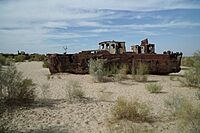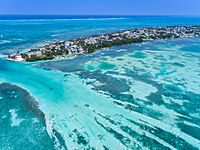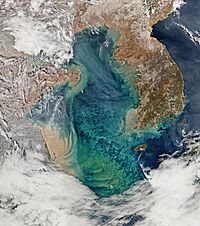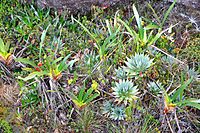IUCN Red List of Ecosystems facts for kids
The IUCN Red List of Ecosystems (or RLE) is a worldwide system that helps us keep track of how healthy different ecosystems are. It was created by the International Union for Conservation of Nature (IUCN). Its main goal is to help protect nature and manage our planet's resources better. The RLE aims to check on all the world's ecosystems by 2025.
The IUCN also created the Red List of Threatened Species. That list helps us monitor how much danger animals and plants are in. The RLE does the same thing, but for entire ecosystems.
With the RLE's help, many governments and groups create their own national or regional lists. These lists help them find and protect ecosystems that are in danger in their own areas.
Contents
How the RLE Started
The Red List of Ecosystems was created to check on nature at a bigger level than just single plants or animals. Before the RLE, different countries had their own ways of checking ecosystems. These ways often didn't match up, making it hard to compare results.
In 2008, at a big meeting in Barcelona, Spain, the IUCN started working on rules for the RLE. They looked at how they already listed endangered species and used those ideas to create rules for ecosystems.
By 2013, the rules for the IUCN Red List of Ecosystems were finished. A book called "Scientific Foundations of an IUCN Red List of Ecosystems" was also published. This book explained the scientific ideas behind the list.
The IUCN officially recognized the RLE in 2014. It is now managed by the IUCN Commission on Ecosystem Management (CEM).
How the RLE Helps
The RLE helps us reach global goals for protecting nature. It lets us see if an ecosystem is in danger of disappearing, either worldwide or in a specific area.
This tool helps us plan how to use land better. It can reduce the damage caused by human activities over large areas. It also helps us use our limited money and efforts for conservation more wisely. The RLE helps us focus on ecosystems that are most likely to disappear. This way, we can work harder to protect them and create safe areas for them.
RLE Categories and Rules
The main part of the IUCN Red List of Ecosystems is its "Categories and Criteria." These are eight categories and five rules that help us figure out how much danger an ecosystem is in.
These rules are made to be:
- Useful for all types of ecosystems and places.
- Clear, scientific, and easy to understand.
- Simple for leaders and the public to use.
Risk Categories





The short names for the RLE risk categories (CO, CR, EN, VU, NT, LC, DD, NE) are always in English. They do not change, no matter what language the document is written in.
Collapsed (CO)
An ecosystem is Collapsed when its main features are almost completely gone from everywhere it used to be. The plants and animals that usually live there can no longer survive. This category is used only when experts are almost 100% sure that the ecosystem has collapsed.
Collapse means an ecosystem has reached its worst point of decline. It is the most extreme result of the RLE assessment. Unlike species extinction, an ecosystem that has collapsed could, in theory, recover.
Currently, only two ecosystems are listed as Collapsed by the IUCN Red List of Ecosystems. These are the Aral Sea in Kazakhstan and Uzbekistan, and the Central Ayeyarwady palm savanna in Myanmar.
Critically Endangered (CR)
An ecosystem is Critically Endangered when it is at an extremely high risk of collapsing. This means there is a 50% chance it could collapse within 50 years. This category is used when an ecosystem has lost a lot of its area (80-90% decline), or if its environment is very damaged.
Endangered (EN)
An ecosystem is Endangered when it is at a very high risk of collapsing. This means there is a 20% chance it could collapse within 50 years. This category is used when an ecosystem has lost a lot of its area (50-70% decline), or if its environment is very damaged.
Some examples of endangered ecosystems are:
- Caribbean Coral Reefs
- Intertidal mudflats of the French Atlantic coast
- Tidal flats of the Yellow Sea
- Coastal lowland rainforests in Queensland, Australia
- Saltmarshes in Moreton Bay, Queensland, Australia
Vulnerable (VU)
An ecosystem is Vulnerable when it is at a high risk of collapsing. This means there is a 10% chance it could collapse within 100 years. This category is used when an ecosystem has lost some of its area (30-50% decline), or if its environment is damaged.
Near Threatened (NT)
An ecosystem is Near Threatened when it doesn't fit into the Critically Endangered, Endangered, or Vulnerable categories right now. However, it is close to qualifying for one of those threatened categories in the near future.
Least Concern (LC)
An ecosystem is Least Concern when it has been checked and does not fit into any of the threatened categories. These are usually widespread and healthy ecosystems. While all ecosystems have some risk of collapse, for these, the risk is very low.
Data Deficient (DD)
An ecosystem is Data Deficient when there isn't enough information to figure out how much risk it is in. This category does not mean the ecosystem is or isn't threatened. It just means more study is needed to find out its risk status.
Not Evaluated (NE)
An ecosystem is Not Evaluated when it has not yet been checked using the RLE rules. This category does not mean an ecosystem is safe. It simply means no one has studied its risk of collapse yet.
Criteria (A-E)
The RLE uses five main rules (A to E) to decide which risk category an ecosystem belongs to:
- A and B look at how much an ecosystem's area has shrunk or if it's found in only a small area.
- C and D look at how much the environment is damaged or if the natural processes within the ecosystem are broken.
- E uses computer models to predict the risk of collapse based on many different threats.
The RLE risk category short names (CO, CR, EN, VU, NT, LC, DD, NE) are always in English. They do not change, no matter what language the document is written in.
How the RLE is Used
The IUCN Red List of Ecosystems rules have been used in many places, from local areas to entire continents. Some countries, like Finland, use these guidelines as their official way to check the risk to their ecosystems.
RLE Guidelines
The "Guidelines for the application of IUCN Red List of Ecosystems Categories and Criteria" are documents that help people use the RLE rules correctly. They explain how the system was developed and the science behind it.
So far, three versions of these guidelines have been published:
- Version 1.0 (2016)
- Version 1.1 (2017)
- Version 2.0 (2024)
Challenges and Importance
The RLE is a fairly new tool, so it's still hard to see its full impact over a long time. However, people and the media have reacted positively to it. It is seen as a very important tool for tracking progress on big international goals, like the Aichi Biodiversity Targets and the Sustainable Development Goals. But it still needs to be used more widely around the world.
One challenge for the RLE is that there isn't one standard way to classify ecosystems. Also, understanding exactly what "ecosystem collapse" means can be tricky. Even though there's strong evidence, predicting when an ecosystem will collapse is complex.
Despite these challenges, using a standard and flexible approach like the RLE has clear benefits. It saves time and money because countries don't have to create their own rules. It also lets different regions share their experiences and learn from each other.
See also
 In Spanish: Lista Roja de Ecosistemas de la UICN para niños
In Spanish: Lista Roja de Ecosistemas de la UICN para niños





